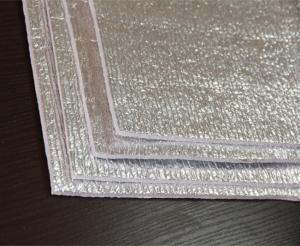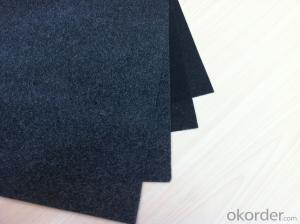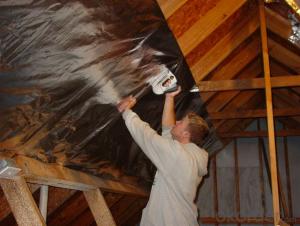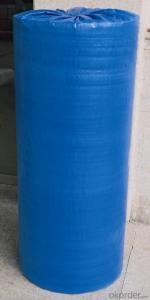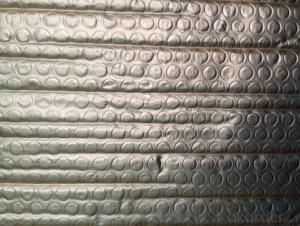60gsm Black Fiberglass Facing Tissue for Acoustic-60C
- Loading Port:
- Shanghai
- Payment Terms:
- TT OR LC
- Min Order Qty:
- 500 m²
- Supply Capability:
- 100000 m²/month
OKorder Service Pledge
OKorder Financial Service
You Might Also Like
Description of Fiberglass Tissue for Thermal Insulation
Fiberglass Tissue is a kind of facing, which is made of by the white fiberglass tissue, and special production process.
Good Aspect of Fiberglass Tissue for Thermal Insulation
Light weight
• Good visual effect
• High reflective insulation
Packing of Fiberglass Tissue for Thermal Insulation
1. Waterproof paper then PVC shrinking Film
2. Water-Proof film only
3. Heat resistant, water proof, stable at high temperature;
4.Environmentally friendly, no smell and not-toxic;
5.Smooth and clear surface;
Specification of Fiberglass Tissue for Thermal Insulation
PROPERTIES | UNIT | VALUE | TEST METHOD |
Basic weight | gsm | 105 | ASTM D646 |
Tensile strength: M. D. X. D. | N/25mm | 140 60 | ASTM D828 |
Burst strength | N | 40 | ASTM D774 |
Reflectivity of foil surface | % | 95 | ---------- |
Temp. Resistance | -29°C 66°C | No Delamination No Delamination | ASTM C1263 |
Water vapor permeance | ng/N.s | 1.15 | ASTM E-96 |
Pictures of Fiberglass Tissue for Thermal Insulation




FAQ
We have organized several common questions for our clients,may help you sincerely:
1. What is the storage condition?
The Aluminum Foil Facing should be stored at room temperature and kept from wet and heat source.
2. How to guarantee the quality of the products?
We have established the international advanced quality management system,every link from raw material to final product we have strict quality test;We resolutely put an end to unqualified products flowing into the market. At the same time, we will provide necessary follow-up service assurance.
3. How long can we receive the product after purchase?
We resolutely put an end to unqualified products flowing into the market. At the same time, we will provide necessary follow-up service assurance.
- Q: Is it possible to utilize black fiberglass tissue as a material that is resistant to fire?
- <p>Yes, black fiberglass tissue can be used as a fire-resistant material. Fiberglass, which is made of glass fibers, is naturally resistant to fire due to its non-flammable nature. It does not burn and can withstand high temperatures without melting, making it an effective insulator against heat. The black color does not affect its fire-resistant properties, and it is often used in construction and industrial applications where fire safety is a concern.</p>
- Q: What are the potential health hazards linked to the use of synthetic materials such as black fiberglass tissues?
- <p>While synthetic materials like black fiberglass tissues have various applications due to their durability and strength, there are health risks associated with their use. Inhalation of fiberglass dust or fibers can cause respiratory issues, including irritation and, in severe cases, respiratory diseases. Prolonged exposure may lead to conditions like fiberglass lung, a form of pneumoconiosis. It's crucial to use proper protective equipment and ventilation when handling these materials to minimize health risks.</p>
- Q: Is it possible to utilize black fiberglass tissue for cleaning hard surfaces?
- <p>Yes, black fiberglass tissue can be used as a cleaning tool for hard surfaces. It is known for its durability and abrasive properties, which make it effective in removing dirt, grime, and even rust. However, it's important to use it with caution as it can scratch softer surfaces. Always test a small, inconspicuous area first to ensure it doesn't damage the surface.</p>
- Q: This question asks for a comparison of the cost of black fiberglass tissue with other fiberglass products.
- <p>The price of black fiberglass tissue can vary significantly compared to other types of fiberglass products due to factors such as quality, thickness, and market demand. Generally, it may be more expensive than standard white fiberglass due to its additional benefits like UV resistance and aesthetic appeal. However, prices can fluctuate based on the manufacturer, the specific product's properties, and the current market conditions. It's best to check with suppliers for the most accurate and up-to-date pricing information.</p>
- Q: This question asks about the positive environmental impacts associated with the use of black fiberglass tissue.
- <p>The environmental benefits of using black fiberglass tissue include its high resistance to UV radiation, which prolongs its lifespan and reduces waste. It's also lightweight, reducing transportation emissions. Black fiberglass tissue is often used in solar panel backings, aiding in energy production and reducing reliance on fossil fuels. Additionally, it's recyclable, contributing to a circular economy and reducing landfill waste. Its durability and resistance to harsh weather conditions also mean fewer replacements are needed, further minimizing environmental impact.</p>
- Q: Is fiberglass facing fire-resistant?
- Yes, fiberglass is fire-resistant. It is made of glass fibers that do not burn and are therefore able to withstand high temperatures without igniting.
- Q: Roof waterproof general use of what materials
- One, asphalt 1. Oil asphalt paper linoleum: three felt four oil or two carpets three oil stack construction. 2. Glass fiber cloth asphalt linoleum, glass fiber felt asphalt felt: cold asphalt binder or hot asphalt binder paste construction.
- Q: What safety measures should be considered when using black fiberglass tissues in a baby's room?
- <p>When using black fiberglass tissues in a baby's room, it's crucial to ensure that the fibers are not inhaled by the baby, as they can be harmful. Always ventilate the room well to disperse any airborne fibers. Avoid using these tissues if the baby is present, and clean up any mess immediately to prevent the baby from coming into contact with the fibers. It's also important to wash hands thoroughly after handling fiberglass tissues to prevent the transfer of fibers to the baby. If possible, consider using alternative materials that are safer for a baby's environment.</p>
- Q: Is it safe to use black fiberglass tissue for food packaging purposes?
- <p>Black fiberglass tissue is not suitable for food packaging. Food packaging materials must be non-toxic and safe for contact with food. Fiberglass, regardless of color, is a type of glass fiber reinforced plastic that can be harmful if ingested or inhaled. It's important to use materials specifically designed for food contact, such as food-grade plastics, paper, or certain types of metal, which are tested and approved for safety in food packaging.</p>
- Q: Is it appropriate to use black fiberglass tissue for cleaning windows or mirrors?
- <p>No, it is not recommended to use black fiberglass tissue for cleaning windows or mirrors. Black fiberglass tissue is typically abrasive and can scratch the glass surface, leaving streaks and reducing clarity. Instead, use a microfiber cloth or a soft, lint-free cloth designed for glass cleaning. These materials are gentle on glass and effectively remove dirt and smudges without causing damage.</p>
Send your message to us
60gsm Black Fiberglass Facing Tissue for Acoustic-60C
- Loading Port:
- Shanghai
- Payment Terms:
- TT OR LC
- Min Order Qty:
- 500 m²
- Supply Capability:
- 100000 m²/month
OKorder Service Pledge
OKorder Financial Service
Similar products
Hot products
Hot Searches
Related keywords







